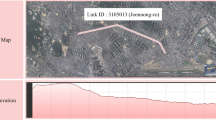Abstract
During the last few decades, bicycle volumes and traffic-bicycle conflicts have increased dramatically in developing countries like India's urban regions. Cycling facilities on urban road segments and junctions must be improved to increase bicycle safety under mixed traffic conditions. The field data were collected at various locations across the city's CBD, where there was a high volume of bicycle traffic. The current study methodology aims to develop bicycle safety index models using variables such as bicycle volumes, bicycle speed (km/hr), bicycle markings, presence of extreme weather (snow fall) conditions, presence of bicycle lanes, pavement surface condition of lane, wide of outside lane, if side path separation, number of through lanes, and motorized traffic volume. The data were collected at various locations in the city's CBD, where there was a high bicycle flow. Bicyclists were classified based on their age and gender. The results of the bicyclist's safety index models were calibrated and validated using multiple linear regression techniques and data collected at various locations. The results of the BSI model rating confirm the correct estimation of bicycle safety levels for urban road segments and junctions. The obtained BSI ratings or scores for different selected locations (BSIKU = 4.2225, BSINIT GATE = 3.3938, BSI Nishat Garden = 4.4139 and R2 values are 0.876–0.67) are discussed in this study. This study discusses the model conclusion based on the codal safety rating level in terms of bicycle safety score index, BLOS and bicycle safety index model ratings. The obtained BSI ratings range from 3 (fair) to 5 (very poor). The study will also be useful in improving existing bicycle facilities, bicycle flows (bicycles per hour), and providing bicycle safety measures for urban roads with mixed traffic and extreme weather (snow fall).




Similar content being viewed by others
References
Carter DL, Hunter WW, Zegeer CV, Stewart JR (2007) Pedestrian and bicyclist intersection safety indices: user guide. Federal Highw Adm (FHWA) 2031:18–24
Hallett I, Luskin D, Machemehl R (2006) Evaluation of on-street bicycle facilities added to existing roadways. Center for transportation research The university of texas at Austin
Horton D (2016) Fear of cycling. In: Horton D (ed) Cycling and society. Routledge, pp 149–168
Petritsch TA, Landis BW, Huang HF et al (2007) Bicycle level of service for arterials. Transp Res Rec 2031:34–42
Asadi-Shekari Z, Moeinaddini M, Zaly SM (2013) Non-motorised level of service: addressing challenges in pedestrian and bicycle level of service. Transp Rev 33(2):166–194
Dixon L (1996) Bicycle and pedestrian level-of-service performance measures and standards for congestion management systems. Transp Res Rec 1538:1–9
Moeinaddini M, Asadi-Shekari Z, Ismail CR, Zaly SM (2013) A practical method for evaluating parking area level of service. Land Use Policy 33:1–10
Davis J (1987) Bicycle Safety Evaluation. Auburn University, City of Chattanooga, and Chattanooga- Hamilton County Regional Planning Commission, Chattanooga, Tenn
Davis J (1995) Bicycle test route evaluation for urban road conditions. transportation congress: civil engineers-key to the world infrastructure; San diego, CA
Cheryl A-M (2003) Development of a multivariate logistic model to predict bicycle route safety in urban areas, Faculty of New Jersey institute of technology
Sorton A, Walsh T (1994) Bicycle stress level as a tool to evaluate urban and suburban bicycle compatibility. Transp Res Rec 1438:17–24
Adinarayana B, Mir MS (2020) Development of bicycle safety index models for safety of bicycle flow at 3-legged junctions on urban roads under mixed traffic conditions. Transp Res Procedia 48:1227–1243
Landis BW, Vattikuti VR, Brannick MT (1997) Real-time human perceptions: toward a bicycle level of service. Transp Res Rec 1578:119–126
Harkey DL, Reinfurt DW, Knuiman M (1998) Development of the bicycle compatibility index. Transp Res Rec 1636:13–20
Landis BW, Vattikuti VR, Ottenberg RM, Petritsch TA, Guttenplan M, Crider LB (2003) Intersection level of service for the bicycle through movement. Transp Res Rec 1828:101–106
Krizek K Estimating the economic benefits of bicycling and bicycle facilities: an interpretive review and proposed methods. Minneapolis, MN: essays on transportation economics; Date unkown
Landis BW (1994) Bicycle interaction hazard score: a theoretical model. Transp Res Rec 1438:3
Landis BW (1996) Bicycle system performance measures. ITE Journal; (February):18–26
Acknowledgements
The authors received no financial assistance for the research, creation, or publication of this article. This data has not previously been presented, and the details of previously published research are related to three-legged junctions rather than extreme weather conditions on urban roads in developing countries.
Author information
Authors and Affiliations
Corresponding author
Ethics declarations
Conflict of interest
The authors proclaimed that no potential conflicting situations regarding the examination, origin, as well as the production of this article.
Rights and permissions
About this article
Cite this article
Adinarayana, B., Kasinayana, B. Bicycle safety index for bicycle level of service on urban streets with extreme mixed weather conditions. Innov. Infrastruct. Solut. 7, 248 (2022). https://doi.org/10.1007/s41062-022-00853-5
Received:
Accepted:
Published:
DOI: https://doi.org/10.1007/s41062-022-00853-5




